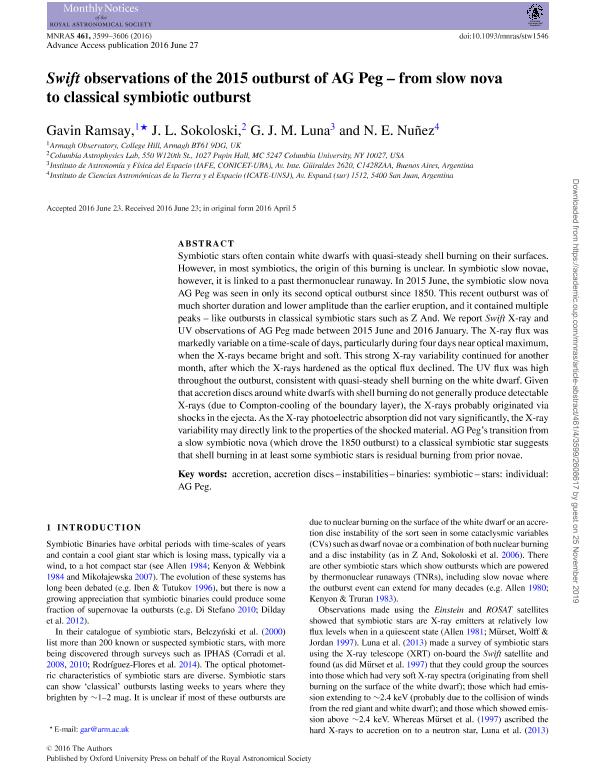Mostrar el registro sencillo del ítem
dc.contributor.author
Ramsay, Gavin
dc.contributor.author
Sokoloski, J. L.
dc.contributor.author
Luna, Gerardo Juan Manuel

dc.contributor.author
Nuñez, Natalia Edith

dc.date.available
2021-03-04T16:11:08Z
dc.date.issued
2016-10
dc.identifier.citation
Ramsay, Gavin; Sokoloski, J. L.; Luna, Gerardo Juan Manuel; Nuñez, Natalia Edith; Swift observations of the 2015 outburst of AG Peg - from slow nova to classical symbiotic outburst; Oxford University Press; Monthly Notices of the Royal Astronomical Society; 461; 4; 10-2016; 3599-3606
dc.identifier.issn
0035-8711
dc.identifier.uri
http://hdl.handle.net/11336/127449
dc.description.abstract
Symbiotic stars often contain white dwarfs with quasi-steady shell burning on their surfaces. However, in most symbiotics, the origin of this burning is unclear. In symbiotic slow novae, however, it is linked to a past thermonuclear runaway. In 2015 June, the symbiotic slow nova AG Peg was seen in only its second optical outburst since 1850. This recent outburst was of much shorter duration and lower amplitude than the earlier eruption, and it contained multiple peaks - like outbursts in classical symbiotic stars such as Z And. We report Swift X-ray and UV observations of AG Peg made between 2015 June and 2016 January. The X-ray flux was markedly variable on a time-scale of days, particularly during four days near optical maximum, when the X-rays became bright and soft. This strong X-ray variability continued for another month, after which the X-rays hardened as the optical flux declined. The UV flux was high throughout the outburst, consistent with quasi-steady shell burning on the white dwarf. Given that accretion discs around white dwarfs with shell burning do not generally produce detectable X-rays (due to Compton-cooling of the boundary layer), the X-rays probably originated via shocks in the ejecta. As the X-ray photoelectric absorption did not vary significantly, the X-ray variability may directly link to the properties of the shocked material. AG Peg's transition from a slow symbiotic nova (which drove the 1850 outburst) to a classical symbiotic star suggests that shell burning in at least some symbiotic stars is residual burning from prior novae.
dc.format
application/pdf
dc.language.iso
eng
dc.publisher
Oxford University Press

dc.rights
info:eu-repo/semantics/openAccess
dc.rights.uri
https://creativecommons.org/licenses/by-nc-sa/2.5/ar/
dc.subject
ACCRETION, ACCRETION DISCS
dc.subject
BINARIES: SYMBIOTIC
dc.subject
INSTABILITIES
dc.subject
STARS: INDIVIDUAL: AG PEG
dc.subject.classification
Astronomía

dc.subject.classification
Ciencias Físicas

dc.subject.classification
CIENCIAS NATURALES Y EXACTAS

dc.title
Swift observations of the 2015 outburst of AG Peg - from slow nova to classical symbiotic outburst
dc.type
info:eu-repo/semantics/article
dc.type
info:ar-repo/semantics/artículo
dc.type
info:eu-repo/semantics/publishedVersion
dc.date.updated
2020-04-28T16:12:31Z
dc.journal.volume
461
dc.journal.number
4
dc.journal.pagination
3599-3606
dc.journal.pais
Reino Unido

dc.journal.ciudad
Oxford
dc.conicet.avisoEditorial
This article has been accepted for publication in Monthly Notices of the Royal Astronomical Society © 2016 The Authors Published by Oxford University Press on behalf of the Royal Astronomical Society. All rights reserved.
dc.description.fil
Fil: Ramsay, Gavin. Armagh Observatory; Reino Unido
dc.description.fil
Fil: Sokoloski, J. L.. Columbia University; Estados Unidos
dc.description.fil
Fil: Luna, Gerardo Juan Manuel. Consejo Nacional de Investigaciones Científicas y Técnicas. Oficina de Coordinación Administrativa Ciudad Universitaria. Instituto de Astronomía y Física del Espacio. - Universidad de Buenos Aires. Facultad de Ciencias Exactas y Naturales. Instituto de Astronomía y Física del Espacio; Argentina
dc.description.fil
Fil: Nuñez, Natalia Edith. Consejo Nacional de Investigaciones Científicas y Técnicas. Centro Científico Tecnológico Conicet - San Juan. Instituto de Ciencias Astronómicas, de la Tierra y del Espacio. Universidad Nacional de San Juan. Instituto de Ciencias Astronómicas, de la Tierra y del Espacio; Argentina
dc.journal.title
Monthly Notices of the Royal Astronomical Society

dc.relation.alternativeid
info:eu-repo/semantics/altIdentifier/doi/http://dx.doi.org/doi:10.1093/mnras/stw1546
dc.relation.alternativeid
info:eu-repo/semantics/altIdentifier/url/https://academic.oup.com/mnras/article/461/4/3599/2608617
Archivos asociados
